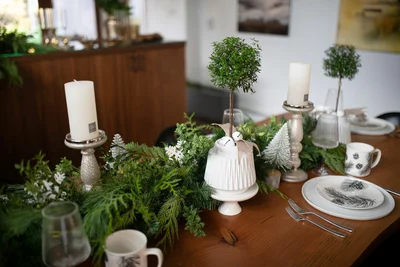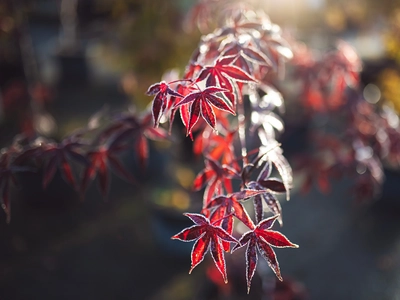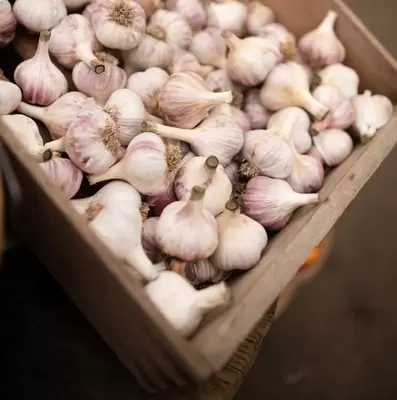
Written by Peter Fitzmaurice
Garlic
I am often asked: “Why grow garlic when you can buy it from the supermarket any time of the year and it is also usually quite inexpensive?” and my response is always “You have never tasted home grown garlic!” This may sound rather arrogant, but the fact remains, there is nothing quite like the taste of fresh, homegrown garlic. This is not only because you have such a wide selection to choose from, but also because garlic harvested from your garden has not been treated and stored. Who knows how long it has been refrigerated at the store? The wonderful thing is that you don’t need to be “an expert” to grow delicious garlic and you also don’t need a huge amount of space to grow it either.
Varieties
Let’s start with varieties that are suitable to grow in our areas. The majority of the garlic suitable to grow in our climate are the hardneck varieties. These are simply varieties that produce a flower stalk, or scape, which forms a hard neck at the base of the plant as opposed to softneck varieties that do not. It should also be mentioned that hardneck varieties, besides being better suited to our region, also tend to have better flavour than softneck varieties. The flower spikes (or scapes) are also a bonus if you grow your own!
GARDENWORKS carries up to 13 varieties which have a wide variety of colour and flavour. If you research these varieties, you will find that each and every one of them, much like wine, has its own nuance in flavour. If you have a discerning palate, you may want to do a bit of research to find the perfect one for you.
The ones we carry are Bogatyr, Chesnok, Duganski, Elephant , German Red, German White, Legacy (rocambole) Metechi, Mexican Purple, Music, Russian Red, Siberian and Spanish Roja
We also carry a wonderful selection of garlic grown by an organic farm in Pemberton. The folk at Rootdown farms grow the following varieties: Red Russian, Northern Quebec, Almighty Red, Armenian and Yugoslavian Porcelain and Persian Star
I should mention that selection varies by store. Please remember that If you are looking for a particular variety and your favourite Gardenworks doesn’t have it, we would be happy to check one of our other stores to see if they have the variety you are looking for.
Growing Garlic in the Garden
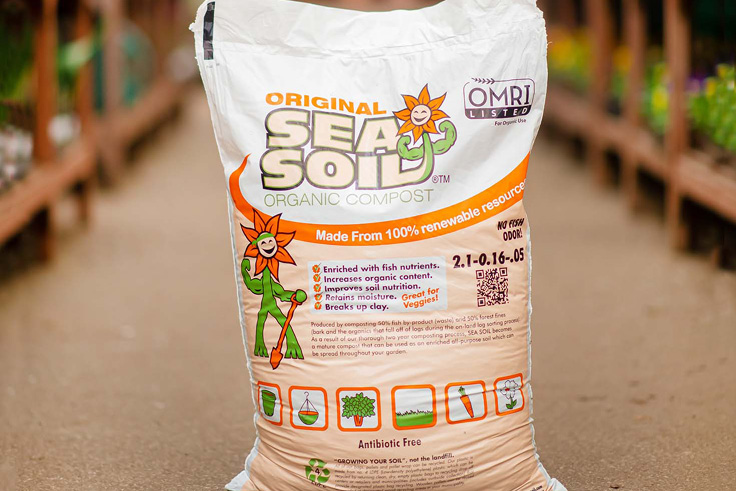 If you are growing your garlic directly in the garden, I suggest preparing the soil by adding a generous amount of well rotted organic material to your soil. GARDENWORKS Mushroom manure or Sea Soil Original are both great choices. This organic material not only improves the structure of the soil but also holds moisture in the soil when the bulbs are growing. Garlic is a heavy feeder so I suggest adding a balanced fertilizer when preparing your soil. My favourite organic fertilizer is Black Gold All Purpose but our GARDENWORKS All Purpose 6-8-6 is also a great choice. The slow-release formulation will boost the nitrogen content of your soil, which garlic love. The good levels of Phosporus and Potasium are nutrients that will improve the overall health of your garlic.
If you are growing your garlic directly in the garden, I suggest preparing the soil by adding a generous amount of well rotted organic material to your soil. GARDENWORKS Mushroom manure or Sea Soil Original are both great choices. This organic material not only improves the structure of the soil but also holds moisture in the soil when the bulbs are growing. Garlic is a heavy feeder so I suggest adding a balanced fertilizer when preparing your soil. My favourite organic fertilizer is Black Gold All Purpose but our GARDENWORKS All Purpose 6-8-6 is also a great choice. The slow-release formulation will boost the nitrogen content of your soil, which garlic love. The good levels of Phosporus and Potasium are nutrients that will improve the overall health of your garlic.
Growing Garlic in Containers
I have successfully growing garlic in containers for years. I love the look of a half wine barrel, but a large plastic planter is just as effective. The large (36”? CHECK) Dylan planter is the ideal size. Garlic does not need deep soil so a planter that is roughly 10-12” deep is ample. For soil, I like to plant garlic in our GARDENWORKS Planter Box Mix with a bit of Sea Soil added. I suggest mixing 3 bags of GARDENWORKS Planter Box Mix with 1 bag of Original Sea Soil. Just as it I was planting garlic directly in the garden; I like to add a handful or two of either Black Gold All Purpose or GARDENWORKS 6-8-6.
Planting Time
The best time to plant your garlic in the Okanagan would be late September to the end of October. For Vancouver Island and Coastal Vancouver, the suggested planting time is mid October to Mid November. Planting too early could result in shoots developing too early which may be damaged by the cold. Note: You may see sprouts appear above the soil before winter sets in. Not to worry, this is natural, as long as they don’t put on too much growth before freezing weather. Tip. If you are concerned, add a layer of straw as a mulch, to prevent damage. Planting too late may result in insufficuient root growth before cold weather sets in which may result in a failed crop.
Planting is simple. First remove the outer skin of the bulb then carefully break up the bulb into its individual cloves being careful not to remove the skins. The skins help prevent desiccation during their vulnerable first months of being in the soil. It is suggested to only prepare your cloves for planting when you are ready to plant to prevent desiccation. Cloves should be pressed into the soil “flat part down” leaving roughly 1 to 2” of soil over the top of the clove. Tamp the soil down lightly and give your newly planted garlic a thorough watering. Our rainy fall climate will usually keep your plants watered during this early stage, but if the weather is dry, it may be advised to lightly water to maintain sufficient moisture to encourage root formation.
Spring to Harvest
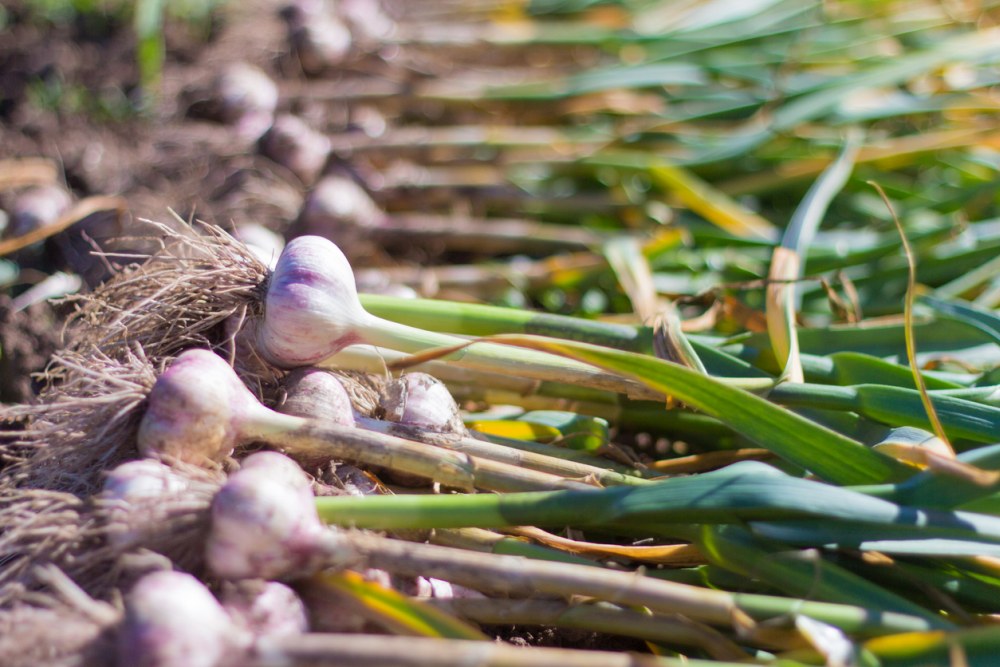 Your garlic will be forming roots over the winter in preparation to sprout out of the ground in early spring. When you first see the sprouting leaves, this is a great time to add another light application of fertilizer. A further few light applications of fertilizer during their growing season will help the plants to form larger bulbs. Keep your garlic adequately watered and avoid lengthy dry spells. Garlic should also no remain constantly moist as this may lead to root rot.
Your garlic will be forming roots over the winter in preparation to sprout out of the ground in early spring. When you first see the sprouting leaves, this is a great time to add another light application of fertilizer. A further few light applications of fertilizer during their growing season will help the plants to form larger bulbs. Keep your garlic adequately watered and avoid lengthy dry spells. Garlic should also no remain constantly moist as this may lead to root rot.
By mid summer, it is recommended to remove the flower spikes (scapes) when they have formed one or two curls. This removal will put all the energy into the bulb and not the formation of the bulbils in the flower spike (scape.) Harvest usually occurs some time in late July or early August. However, a good rule of thumb is when the lower 3 or 4 leaves have turned brown and the plants are looking a bit stressed. I always lift one to see the progression and then decide if my crop is ready for harvest or whether I should wait another week or two.
I hope you enjoy growing garlic as much as I do.
Watch our "How-To" video!

